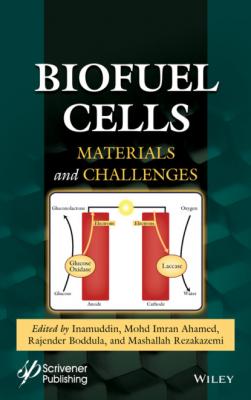Biofuel Cells. Группа авторов
Читать онлайн.| Название | Biofuel Cells |
|---|---|
| Автор произведения | Группа авторов |
| Жанр | Физика |
| Серия | |
| Издательство | Физика |
| Год выпуска | 0 |
| isbn | 9781119725053 |
Table 1.3 Mechanism for extracellular electron transfer at the interface microorganism-electrode. Direct electron transfer (DET), mediated electron transfer (MET).
| Extracellular electron transfer | |
| DET | MET |
| Membrane proteins | Primary metabolites |
| Pili structures | Secondary metabolites |
| Exo-polymeric matrix | Artificial redox mediators |
Table 1.4 Types of proteins involved in the EET in Geobacter sp. and Shewanella sp.
| Species | Type of protein | Location in the cell | Reference |
| Geobacter | ImcHCbcL | Cytoplasmic membrane | [154] |
| PpcAPpcD | Periplasm | [155] | |
| Omas | Form the trans-outer membrane protein complex with the porin-like outer membrane proteins. | [156] | |
| Omcs | |||
| OmbB | |||
| OmbC | |||
| Shewanella | CymA | Cytoplasmic membrane | [157] |
| Fcc3Small tetrahaem cytochrome | Periplasm | [158] | |
| MtrCBA | Outer membrane | [159] |
A mixed mechanism of EET comprises redox mediators embedded in the exo-polymeric matrix. The concentration and mobility of these molecules could contribute in some degree to the global electron transfer; however, this mechanism is not completely sustained by calculations of the electrical current produced from possible concentration of a mediator [163].
MET via metabolites depends not only on the microbial species but the physiological state, growth phase and environmental conditions in which the bacteria develops. Primary metabolites are directly related to the substrate oxidation. For instance, hydrogen is the most interesting metabolite in the internal and external electron transport chain due to its ubiquity. Secondary metabolites are produced with an additional consumption of energy, examples of secondary metabolites acting as mediators are pyocianine and 2-amino-3-carboxy-1,4-naphtoquinone. Early studies on MET utilized synthetic mediators such as anthraquinone-2,6-disulfonate to mimic natural mediators [164].
1.6 Bioelectrocatalysis Control
1.6.1 Control of Enzymatic Bioelectrocatalysis
Enzyme performance is a function of the environmental conditions such as temperature and pH. This latter parameter is of particular importance in enzymatic glucose/oxygen biofuel cells. While glucose oxidase performs better at pH values around 7–8, laccase does so at significantly lower pH (around 4.5–5.5) [7, 50]. This imposes restrictions in single-compartment fuel cells, where both enzymes are exposed to a single solution of a given composition. A compromise must be made to obtain the best performance. Figure 1.12a shows the cyclic voltammograms of a GOx anode and a laccase cathode in solutions of pH 5.5 and 7.4. It can be seen that, despite GOx performing significantly better at pH = 7.4, cathode limitations would be substantial due to the low currents produced by the laccase electrode. A better compromise occurs at pH = 5, where GOx shows a decreased performance (about 50% compared to pH = 7.4) but the increase in laccase current makes for a more balanced system. As a result, a 2.5-fold increase in power is observed when evaluating the complete cell at pH = 5.5 compared to pH = 7.4 (Figure 1.12b).
A way to achieve optimal pH for both enzymes is to use a divided cell. In this case, the cathodic and anodic chambers are separated by a membrane typically made of Nafion [7, 53]. This proton-exchange membrane allows the passage of charge in the form of cations but allows maintaining two different compositions of the catholyte and anolyte solutions. Besides allowing maintaining different acidity levels for each electrode, compartment separation avoids reagent and product crossover between the electrodes. Due to the enzymes’ intrinsic selectivity, the presence of a reactant at the opposite electrode is not as detrimental to the cell voltage as in inorganic fuel cells. The product of one of the reactions, however, might be undesirable for the enzyme at the opposite electrode. Such is the case of hydrogen peroxide, which is produced by GOx, and to which bilirubin oxidase and laccase are sensitive [165].
Figure 1.12 Characterization of the performance of a GOx anode and a Lac cathode through cyclic voltammetry (a) and power curves (b) at two different pH values. Black lines and symbols correspond to pH = 5.5 while grey ones are obtained at pH = 7.4. Republished with permission of the Royal Society of Chemistry, from Chem. Commun., Saravanan Rengaraj et al., 47, 2011, 11861–11863; permission conveyed through Copyright Clearance Center, Inc.
Recently, laminar flow has been explored as another alternative to separate anolyte and catholyte solutions without the need for a membrane. In electrode compartments of reduced dimensions, low Reynolds number regimes exist, preventing solutions from mixing through turbulence. Therefore, the membrane can be obviated. In practice, such systems have taken the form of microfluidic fuel cells in which glucose oxidase, lactate oxidase and laccase and have been employed [107, 148, 166].
The performance of the cell is also determined by the availability of fuel and oxidant at the anode and cathode respectively. Glucose, like many of the fuels, can be employed in solution at high concentrations, therefore ensuring availability at the anode. Oxygen, on the other hand, has a much lower solubility in aqueous solutions, as well as a low diffusion coefficient. Therefore, cathode performance usually limits the overall cell output. A good strategy to increase the availability of oxygen is the incorporation of “air-breathing” cathodes. These electrodes are typically composed of a carbon conductor (in the form of paper) with a hydrophobic membrane. This membrane is generally fabricated with some fluoropolymer and allows the gas exchange between the catholyte and the atmosphere without allowing solution to leak. Such electrodes are therefore exposed to both oxygen dissolved in solution and in gas form from the atmosphere. This strategy has been used in inorganic [144, 167, 168]
